#Ernest Flammarion
Explore tagged Tumblr posts
Text
ventisei maggio

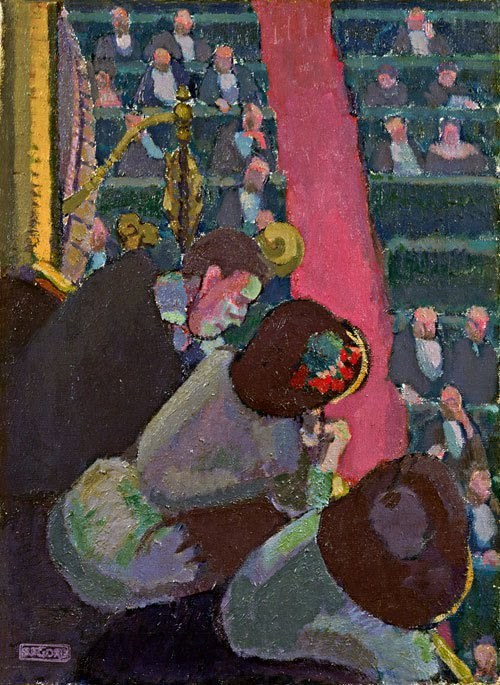
Spencer Gore, Balcony at the Alhambra, 1910-11
Lo spirito della depravazione
Mi ripugna questo mondo nel quale l’uomo domina sull’uomo E ancor di più mi ripugna l’umanità che non vuole con ciò fare i conti Ma più di tutto ancora mi ripugna la mia propria impotenza a fare i conti con i suoi assassini Anche perché non sono poi neanche così tanti Da non poterli strangolare a mani nude
View On WordPress
#Edmond de Goncourt#Enrico Castelnuovo#Ernest Flammarion#ʿAlāʾ al-Aswānī#Giorgio Samorini#Miles Davis#Moondog (Louis Hardin)#Spencer Gore#Sven Delblanc#Vítězslav Nezval#Walter Laqueur
0 notes
Text
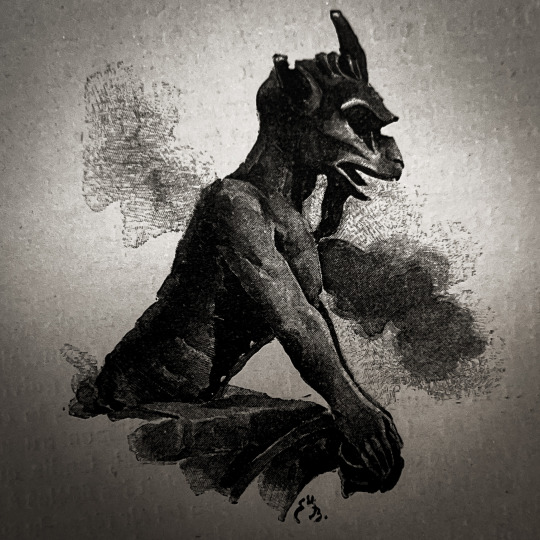
With Halloween only a few days away, we fittingly conclude our Gothic series with a contemplation of those ghoulish creatures known as gargoyles. The word “gargoyle” derives from the Old French “gargoule” meaning “throat” and, strictly speaking, refers to the Gothic architectural detail that channels water away from the walls of buildings. Laon Cathedral, a thirteenth-century structure in Laon, France, is believed to have the earliest medieval gargoyles.
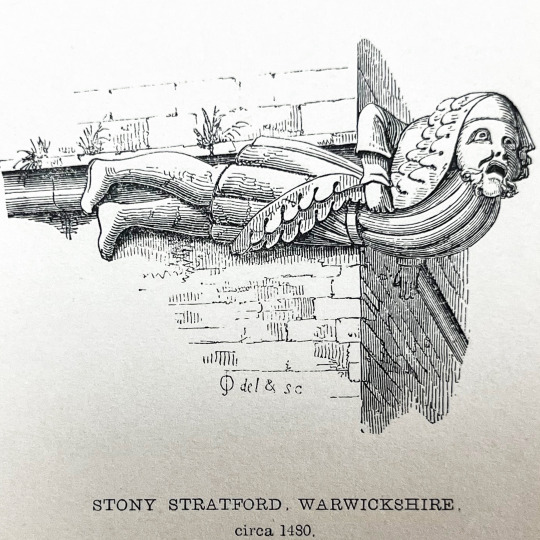
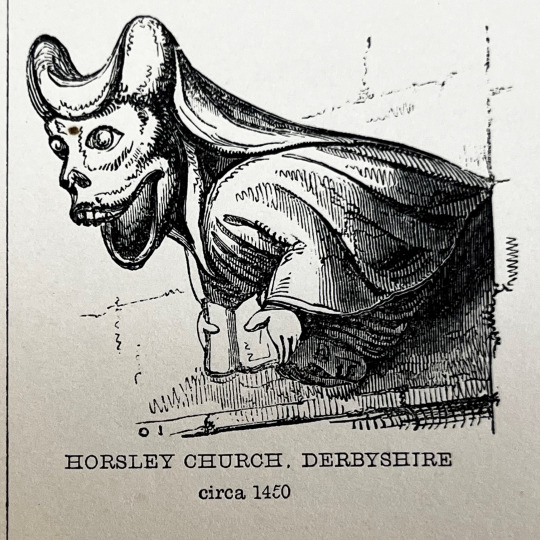
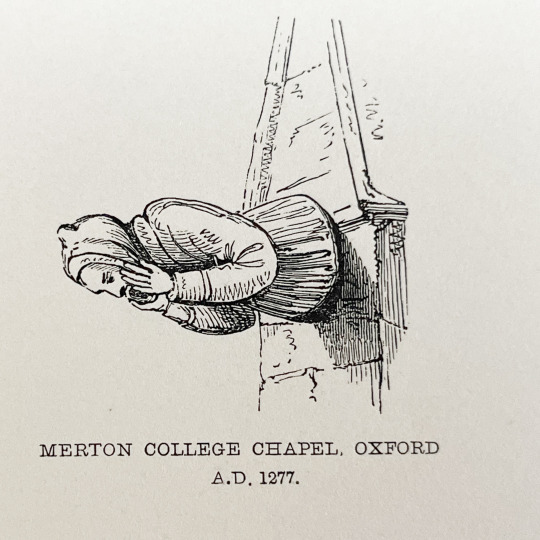
Scholars have long debated whether the chimerical design of these waterspouts was meant to ward off or embody evil spirits…or neither. Regarding gargoyles, art historian Lester Burbank Bridaham advises “we must be wary of reading in too much meaning.” Whether to protect, frighten, or entertain, gargoyles and their related grotesques have captured the human imagination for centuries.
John Henry Parker's Architectural Glossary (1845-1846)
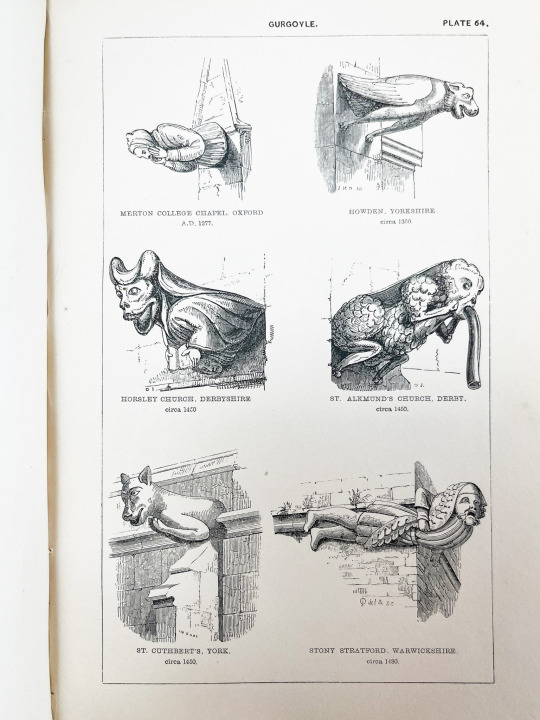
Engraved plate depicting various gargoyles found on English medieval buildings, ca. 1277-1480, from a mid-nineteenth century architectural glossary compiled by John Henry Parker. Wanting to see the Gothic Revival movement flourish, Parker also edited an edition of Thomas Rickman’s Gothic Architecture (1848) and published an Introduction to the Study of Gothic Architecture (1849).
Victor Hugo's Notre-Dame de Paris (1888)
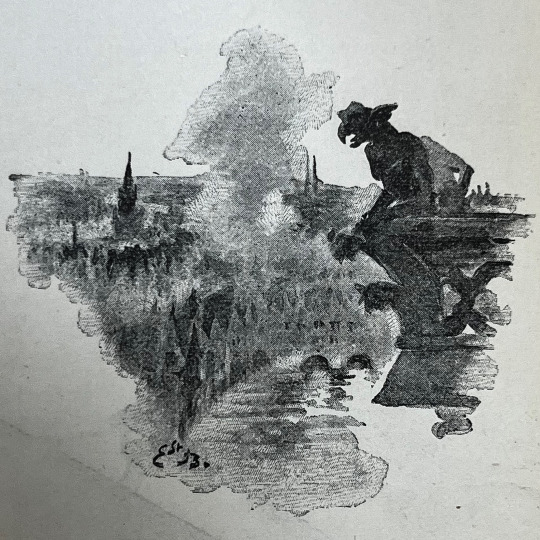
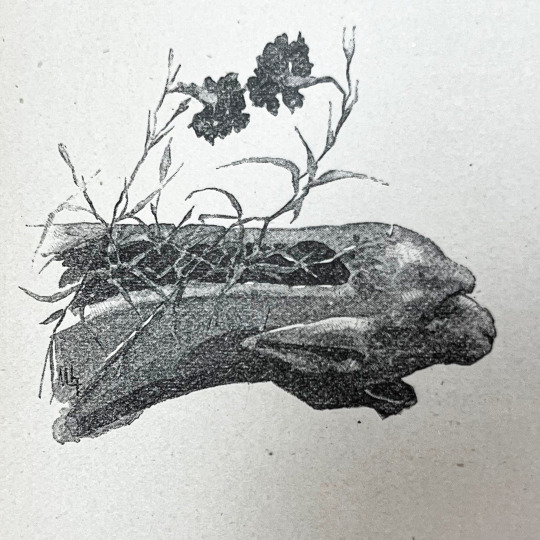
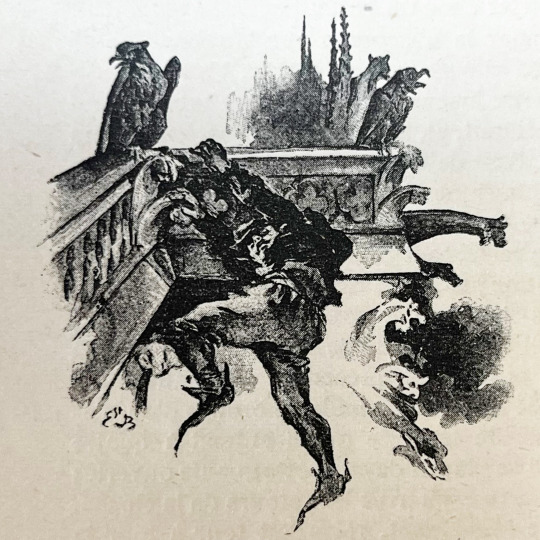
Gargoyles loom large in this illustrated edition of Victor Hugo’s Notre-Dame de Paris, also known by the English title The Hunchback of Notre Dame. The Notre Dame gargoyles do not come to life as they do in the 1996 Disney animated film adaptation, but, in a romantic sense, Quasimodo bears a kinship with the gargoyles since both form integral parts of the famous Parisian cathedral. Quasimodo imbues Notre Dame (including her gargoyles) with life: “Il semblait qu’il s’echappât de lui ... une émanation mystérieuse qui animait toutes les pierres de Notre-Dame…” Illustrations by Ernest Biéler and Felician Myrbach.
L. Frank Baum's Dorothy and the Wizard in Oz (1908)
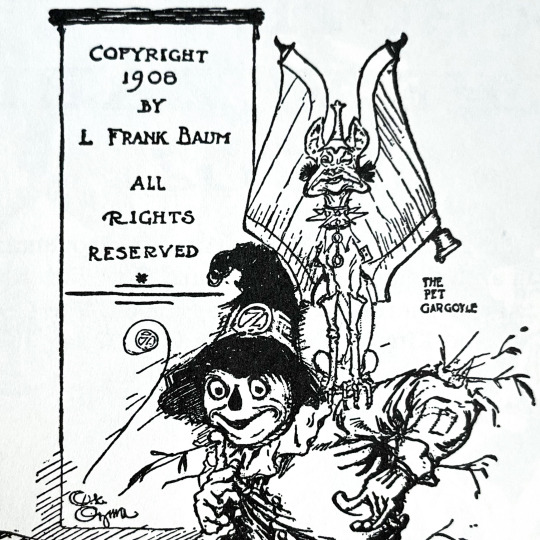
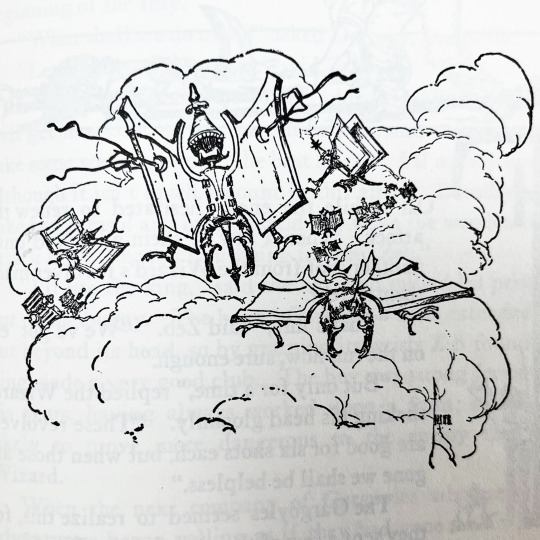
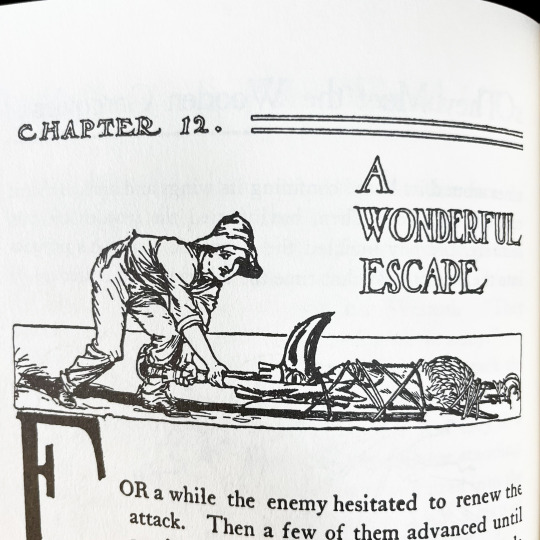
In L. Frank Baum’s Dorothy and the Wizard in Oz, the Wizard, Dorothy, and the rest of their band of adventurers come across the Country of the Gargoyles (or “Gurgles” as Dorothy calls them). The gargoyles in the Ozian universe are sentient creatures who live in a world made entirely out of wood. The gargoyles themselves are also carved from wood and have magical wooden wings that give them the power of flight. In the course of battle with the Gargoyles, Dorothy’s cousin Zeb manages to capture the Gargoyle king and use him as a wooden club. Illustrations by John R. Neill.
Images from:
Parker, John Henry. A Glossary of Terms used in Grecian, Roman, Italian, and Gothic Architecture. Oxford: John Henry Parker, 1845-1846. Catalog record: https://bit.ly/3SJyZPA
Hugo, Victor. Notre-Dame de Paris. Paris: C. Marpon et E. Flammarion, ca. 1888. Catalog record: https://bit.ly/3SBpwtO
Baum, L. Frank. Dorothy and the Wizard in Oz. Chicago: Reilly & Lee, 1908.
103 notes
·
View notes
Text


L' oeuvre de Gustave Le Bon par Le Baron Motono Ambassadeur du Japon à Saint-Pétersbourg
Ernest Flammarion, éditeur - 1914
#L' oeuvre de Gustave Le Bon#Le Baron Motono#ernest flammarion éditeur#gabinete 63 curiosidades bibliográficas
0 notes
Text
Practical Boxing; Offensive and Defensive Advice for Street Combat by Julien Leclerc
“ INTRODUCTION BY THE AUTHOR
The method which I present to the reader is to my regret that of Charles Lecour; I have made several additions in English boxing. It is composed of kicks and punches.
With the exception of kicks aimed higher than the waist all kicks are thrown by the old method, called “savate”, when taught in their low dives and pimphouses, a method of little aristocracy, born on street corners, in terrible brawls where the relative value of these various blows were clearly established, where little by little there were perfected. All matters of punching come from English boxing. Our cousins over the Channel, graced by the public assaults which are frequent among them, are better edified than ours on the merit of inferiority of such and such attack or such and such guard and I have nothing better to do than to benefit from their example.
The present method, born of the ring and pavement, is thus essentially practical and I assure that a gifted pupil who possess this thoroughly is almost invulnerable.
French boxing has only the aim of allowing pupils to make in assaults more or less graceful blows, which have some effect on the spectators.
It must uniquely place you all the same, in a serious combat, able to overcome rapidly and certainly an adversary of strength superior to your own.
My method is, for the part on kicking, what I call technically a “low method”, that is to say composed especially of attacks to the legs; these attacks are very effective, given the extreme sensitivity of the tibia, ankles, knees etc…
The speed with which we perform and develop in one action and direct with minimum trajectory rend them at once very rapid and very violent. One of my pupils cannot, for example, hit with a low chassé in the street without putting his adversary thoroughly out of the fight; in addition it does not compromise the balance of the body as do high blows.
Punches are, thus as has been said, pure English boxing. One will come to double the point of view on their rapidity and hardness that one will at first have pain to reconcile. They form into one a very serious system of defence and it is only in story books that kicks overcome, when brought against each other, the English game.
This has often served the legend of a Parisian waif defeating the champion of London with a full kick in the face.
Clearly French Boxing causes more arguments than English boxing; but do not forget the latter makes an integral part of the former and that a French boxer does not have the advantage over an English boxer who has equal skill and training. “
5th Edition, 1904 PARIS ERNEST FLAMMARION, EDITOR 26, Rue Racine Translated P.T. Crawley, 2015
The full pdf with the actual techniques and principles explained in detail can be found here.
Ringen discussiongroup! is a good place to check out if you’re interested in historical wrestling variants, as are HEMA Grapplers and Scholars of Fiore dei Liberi.
The first group focuses on ringen, the second is about more general historical wrestling types,the third on armizare, the wrestling portion of which is called abrazare.
If you’re interested in learning about historical forms of boxing or as it was often called pugilism check out HEMA pugilists
If you are interested in more modern forms of unarmed combat do check out Southpaw's Mixed Marxist Arts Club
#hema#pugilism#ringen#old school boxing#old school grappling#grappling#boxing#julien leclerc#leclerc#french boxing#savate#english boxing
44 notes
·
View notes
Text
LONGS FORMATS
longsformats.com
Production et réalisation de reportages, enquêtes, entretiens, portraits et documentaires au long cours, dans la tradition du journalisme engagé (concerned).
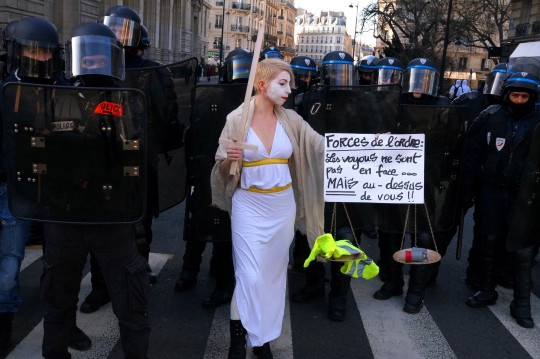
Journalisme engagé
“Le véritable journalisme est toujours motivé, c’est-à-dire qu’il se fixe des objectifs et vise à instaurer une forme de changement. Le bon journalisme ne peut qu’être ainsi. Si vous lisez les textes des meilleurs journalistes, les œuvres de Mark Twain, Ernest Hemingway, Gabriel Garcia Marquez, vous constaterez vous-mêmes qu’ils ont pratiqué un journalisme engagé. Chacun d’eux se bat pour une cause. Il raconte pour atteindre un but, pour obtenir un résultat.”
Ryszard Kapuściński, Autoportrait d’un reporter, Plon, 2008 (textes choisis par Krystyna Strączek ; traduit du polonais par Véronique Patte), et Flammarion, 2010 (présentation, choix de textes, notes et dossier par Patrice Kleef, traduction [du polonais] de Véronique Patte).
Pour Pascual Serrano, qui dans son maître-ouvrage* évoque le journalisme engagé tel que le pratiquaient des auteurs comme Rodolfo Walsh, Robert Capa, Edgar Snow ou Ryszard Kapuściński, un des talents de John Reed* était de donner la parole aux protagonistes des histoires, qu’il s’agisse des grandes grèves du textile à Paterson, aux États-Unis, de la rébellion des contrées poussiéreuses du nord du Mexique, des tranchées de la Grande Guerre en Europe ou du Palais d’hiver à Petrograd, où les bolcheviques ont établi leur quartier général. L’objectif était de faire tomber les stéréotypes à partir de l’information et de la vérité. Ce que John Reed énonce clairement dans la préface de son livre sur la révolution russe (Dix jours…) : « Dans la lutte, mes sympathies n’étaient pas neutres. Mais, lorsqu’il s’est agi de relater l’histoire de ces grandes journées, je me suis efforcé de contempler le spectacle avec les yeux d’un reporter consciencieux, attaché à dire la vérité. » * Contra la neutralidad. Tras los pasos de John Reed, Ryszard Kapuściński, Rodolfo Walsh, Edgar Snow y Robert Capa, Barcelone, Ediciones Península, 2011. ** Auteur du Mexique insurgé (1914), un recueil de reportages sur la révolution mexicaine, et des Dix jours qui ébranlèrent le monde (1919), la plus célèbre chronique de la révolution russe de 1917.
Concerned
Cornell Capa (1918–2008) chose the phrase « concerned photographer » to describe those photographers who demonstrated in their work a humanitarian impulse to use pictures to educate and change the world, not just to record it. During a long career as a photographer, Capa worked for « Life magazine » from 1946 to 1967, and for the Magnum Photos agency beginning in 1954, covering social and political issues in the United States, as well as England, the Soviet Union, Israel, and Central and South America… « Concerned photography » is the recording of what the world looks like, with a social and/or environmental focus. It is a form of documentary photography, with the aim to draw the public’s attention to ongoing social issues. It may also refer to a socially critical genre of photography.
Cornell Capa (né Kornél Friedmann, frère cadet de Robert Capa) a choisi l’expression « photographe concerné » (ou « photographe engagé ») pour décrire celles et ceux qui montraient dans leur travail un motif humanitaire à utiliser des images pour instruire et changer le monde, pas seulement pour l’observer. Au cours d’une longue carrière de reporter, C. Capa a travaillé pour Life magazine, de 1946 à 1967, et pour l’agence Magnum Photos, à partir de 1954, couvrant principalement des sujets sociaux et politiques aux États-Unis, ainsi qu’en Angleterre, Union soviétique, Israël, en Amérique centrale et du Sud… La “photographie engagée” fait le constat de ce à quoi le monde ressemble, avec un accent social ou environnemental. Il s’agit d’une forme de photographie documentaire et critique, dont le but est d’attirer l’attention du public sur les problèmes sociaux. Observateur critique
“Je me suis autodésigné comme observateur critique de la société dans laquelle je suis né, avec une tendance à faire honneur et donner une reconnaissance à ce qui est souvent ignoré ou invisible.” David Goldblatt Documentaire critique
“Ainsi, nous entendons ne pas laisser dans l’ombre qui et quoi que ce soit, et cela fonde à notre sens un projet documentaire. Nous ne saurions refuser le monde, ses évidences, au profit d’un monde uniquement tourné vers le profit, l’exclusion, l’exploitation, le nationalisme étroit. Nous préférons considérer, au contraire, les subalternes, ceux qui sont les grands acteurs de l’Histoire bien qu’ils aient disparu des sphères organisées de la visibilité. (…) La photographie documentaire entend s’exercer comme une des modalités de pensée critique du monde, pour le pire et le meilleur, mais surtout dans un large mouvement prospectif pour l’avenir.” Philippe Bazin
Une façon de vivre
“L’appareil photographique est pour moi un carnet de croquis, l’instrument de l’intuition et de la spontanéité, le maître de l’instant qui, en termes visuels, questionne et décide à la fois. Pour « signifier » le monde, il faut se sentir impliqué dans ce que l’on découpe à travers le viseur. Cette attitude exige de la concentration, de la sensibilité, un sens de la géométrie. C’est par une économie de moyens et surtout un oubli de soi-même que l’on arrive à la simplicité d’expression. Photographier : c’est retenir son souffle quand toutes nos facultés convergent pour capter la réalité fuyante ; c’est alors que la saisie d’une image est une grande joie physique et intellectuelle. Photographier : c’est dans un même instant et en une fraction de seconde reconnaître un fait et l’organisation rigoureuse de formes perçues visuellement qui expriment et signifient ce fait. C’est mettre sur la même ligne de mire la tête, l’œil et le cœur. C’est une façon de vivre.” Henri Cartier-Bresson
L’humanité de l’instant
“S’il est une chose que doit posséder une photographie, c’est l’humanité de l’instant. Cette forme de photographie est appelée réalisme. Mais le réalisme seul ne suffit pas. Il doit être visionnaire. C’est à ce prix qu’une photographie pourra être réussie. La ligne est ténue où s’arrête le sujet et commence l’esprit.” Robert Frank
2 notes
·
View notes
Photo

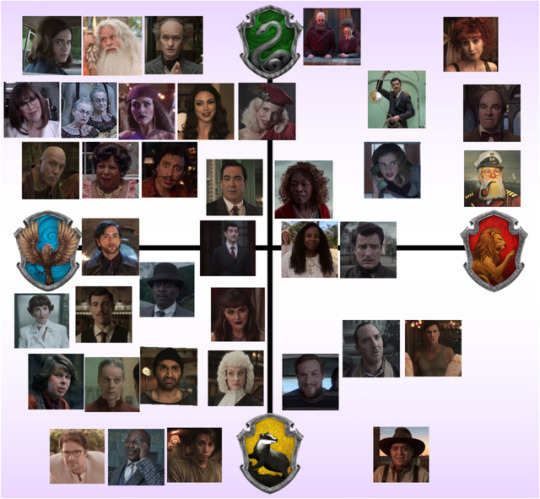
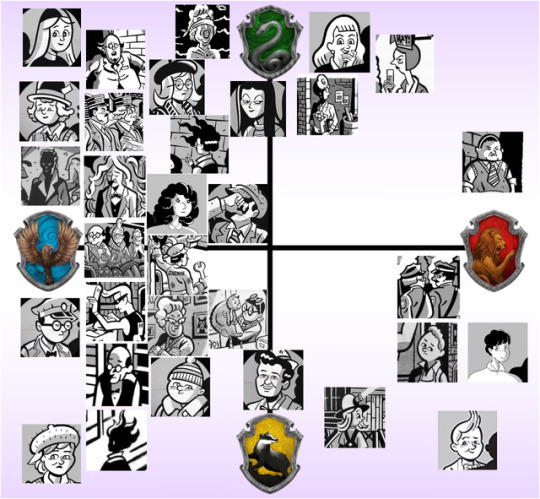
first person to say “you forgot [insert character here]” gets slapped with a fish
more detailed notes under the cut
Edit: the amazing @amr102-art made us Florence + Drumstick icons so I added them and Kevin to the ATWQ chart!
italicized house is the one I fancy over the other for said character
in alphabetical order by surname (if available) because holy shit why are there so many of you
The Unfortunate Generation
Violet Baudelaire: Slytherin/Ravenclaw
Klaus Baudelaire: Ravenclaw/Hufflepuff
Sunny Baudelaire: Slytherin, leaning slightly more towards Ravenclaw than Gryffindor
Movie!Violet/Lilac Baudelaire: Ravenclaw/Hufflepuff
Movie!Klaus/Nick Baudelaire: Gryffindor
Movie!Sunny/Solitude Baudelaire: Hufflepuff
Beatrice Baudelaire II: Slytherin/Gryffindor
Friday Caliban: Ravenclaw/Hufflepuff
Duncan Quagmire: Hufflepuff/Ravenclaw
Isadora Quagmire: Ravenclaw/Slytherin
Quigley Quagmire: Mix of All Four {I personally prefer Gryffindor but his character is very centered}
Carmelita Spats: Gryffindor/Slytherin
Fiona Widdershins: Slytherin/Ravenclaw
The Sugar Bowl Generation
Josephine Anwhistle: Gryffindor/Slytherin
Babs: Ravenclaw/Hufflepuff
Bald Henchman: Ravenclaw/Slytherin
Bearded Man (Volunteer Fighting Disease): Hufflepuff/Gryffindor
Beatrice Baudelaire: Slytherin/Ravenclaw
Bertrand Baudelaire: Hufflepuff/Ravenclaw
Miranda Caliban: inbetween Slytherin/Hufflepuff, closer to Gryffindor than Ravenclaw
Book!Olivia Caliban: Slytherin/Ravenclaw
Netflix!Olivia Caliban: Hufflepuff/Ravenclaw
Colette: Slytherin/Gryffindor
Count Olaf: Slytherin/Ravenclaw
Dewey Denouement: Ravenclaw/Hufflepuff
Ernest Denouement: Slytherin/Gryffindor
Frank Denouement: Ravenclaw
Vice Principal Nero Feint (surname via Netflix): Slytherin/Gryffindor
Hal: Hufflepuff/Ravenclaw
Hector: Hufflepuff/Gryffindor
Henchperson of Indeterminate Gender: Ravenclaw/Hufflepuff
Hugo: Hufflepuff/Ravenclaw
Ishmael: Slytherin/Ravenclaw
Kevin: Gryffindor/Hufflepuff
Monty Montgomery: Slytherin/Ravenclaw
Georgina Orwell: Slytherin/Ravenclaw
Gruesome Twosome (Man with Beard, Woman With Hair): Slytherin/Gryffindor
Arthur Poe: Ravenclaw/Hufflepuff
Eleanora Poe (Netflix): Ravenclaw/Slytherin
Jacquelyn Scieszka (Netflix): Gryffindor/Slytherin
Gustav Sebald (Netflix): Ravenclaw
Jacques Snicket: Gryffindor
Kit Snicket: Slytherin/Ravenclaw
Lemony Snicket: Ravenclaw/Slytherin
Justice Strauss: Hufflepuff/Ravenclaw
Esme Squalor: Slytherin
Jerome Squalor: Hufflepuff/Gryffindor
White-Faced Women: Slytherin/Ravenclaw
Captain Widdershins: Gryffindor/Slytherin
Fernald Widdershins: Hufflepuff/Ravenclaw
Larry Your-Waiter (Netflix): Hufflepuff/Ravenclaw
All the Wrong Questions/13 Suspicious Incidents
Pip Bellerophon: Ravenclaw/Hufflepuff
Squeak Bellerophon: Hufflepuff/Ravenclaw
Tatiana Cozy: Slytherin/Ravenclaw
Treacle Cozy: Hufflepuff/Ravenclaw
Nurse Dander: Slytherin/Gryffindor
Drumstick: Gryffindor/Hufflepuff
Armstrong Feint: Ravenclaw/Slytherin
Ellington Feint: Slytherin, much closer to Ravenclaw than Gryffindor
Erastosthenes, Pocket and Walleye, the Librarians: Ravenclaw
Dr Flammarion: Ravenclaw/Slytherin
Gifford and Ghede: Ravenclaw/Slytherin
Marguerite Gracq: Hufflepuff/Gryffindor
Kellar Haines: Hufflepuff/Gryffindor
Lizzie Haines: Slytherin/Gryffindor
Sharon Haines: Slytherin/Gryffindor
Jake Hix: Hufflepuff
Jackie: Ravenclaw, closer to Hufflepuff than Slytherin
Cleo Knight: Slytherin/Ravenclaw
Ornette Lost: Ravenclaw/Hufflepuff
Prosper Lost: Hufflepuff/Ravenclaw
Moxie Mallahan: Ravenclaw/Slytherin
S Theodora Markson: Ravenclaw/Slytherin
Harvey and Mimi Mitchum: Gryffindor/Hufflepuff
Stew Mitchum: Gryffindor/Slytherin
Dame Sally Murphy: Slytherin/Ravenclaw
Kevin Old: Gryffindor/Hufflepuff
Polly Partial: Hufflepuff/Ravenclaw
Oliver Sobol: Hufflepuff/Ravenclaw
Florence Smith: Ravenclaw/Slytherin
Kit Snicket: Slytherin/Ravenclaw
Lemony Snicket: Ravenclaw/Slytherin
Dashiell Qwerty: Ravenclaw/Hufflepuff
#asoue#a series of unfortunate events#all the wrong questions#atwq#asoue netflix#file under: 13 suspicious incidents#hogwarts au#hogwarts vfd#mine#alignment charts
272 notes
·
View notes
Quote
Fiamette avait rempli la chambre de violettes, et toute la campagne endeuillée semblait renaître avec ses verdures, ses eaux et ses forêts dans le jaune d'or d'une branche de mimosas. La jeune femme se rappelait une joie pareille lorsque, petite fille, elle s'était réveillée à l'orée d'un bois, chez un de ses grands parents qui était garde dans les environs de Paris. Elle avait eu la même impression de félicité et de quiétude, et cette impression, alors, ne lui avait pas semblé nouvelle, comme si elle eût subi l'influence de souvenirs lointains, antérieurs à sa naissance : des souvenirs qu'un rien avait suffi à ressusciter et qui chantaient mystérieusement dans son âme.
Jane de La Vaudère, Les Androgynes. Roman passionnel, Paris, Ernest Flammarion, 1903.
#Jane de la Vaudère#Les Androgynes#Femme de lettres#femme exceptionnelle#décadence#littérature décadente#Fin-de-siècle
3 notes
·
View notes
Photo


Des Chats : Images Sans Paroles (Quelques Chats : Photos Sans Mots) http://www.mfa.org/collections/object/des-chats-images-sans-paroles-some-cats-pictures-without-words-155562 1898 Théophile-Alexandre Steinlen (français (né en Suisse), 1859-1923), éditeur Ernest Flammarion (français, 1846-1936) Lieu d'édition : Paris, France Ouvrage illustré contenant de nombreux gillotypes après dessins, ainsi qu'une couverture en lithographie couleur Livres illustrés (Paris: Ernest Flammarion [1898?]) Folio; 28 feuilles; Tissu mi-gris, planches lithographiques originales de l'artiste. Illustrations de chats, accompagnés de personnes, d'autres animaux, etc. Paris: Ernest Flammarion [1898?] © 2018 Musée des Beaux-Arts, Boston
#des chats#images sans parole#illustrations#planche originale illustrée#illustrations pour enfants#illustrations de livres#livres pour enfants#livres#livres jeunesse#planche illustrée cha cha cha#le chatnoirdelalune#théophile alexandre steinlen#steinlen#illustrateur français#suisse#f rance#illustrateur livres pour enfants#illustrateur de livres#livre#books children#book child#children#child
16 notes
·
View notes
Photo








GASTRONOMIE PRATIQUE de ALI-BAB (Dr.HENRI BABINSKI) 3ª EDICIÓN PARIS 1923
GASTRONOMIE PRATIQUE. ÉTUDES CULINAIRES SUIVIES DU TRAITEMENT DE L´ OBÉSITÉ DES GOURMANDS - ALI-BAB
TROISIÈME ÉDITION ENTIÈREMENT REFONDUE ( 3ª EDICIÓN) 1923
ERNEST FLAMMARION, ÉDITEUR PARIS
1107 PÁGINAS
IDIOMA: FRANCÉS
MEDIDAS: 28 x 22,5 x 8,2 cms
ESTA GUÍA CULINARIA PRÁCTICA PUBLICADA POR PRIMERA VEZ EN 1907, OFRECE UN ENFOQUE TANTO TÉCNICO COMO HISTÓRICO CON MÁS DE 5000 RECETAS DETALLADAS. TAMBIÉN RECOGE TEXTOS SOBRE LA CIENCIA DE LOS ALIMENTOS Y DE LAS BEBIDAS. ESTÁ CONSIDERADA,JUNTO A LA GUIA CUILINAIRE DE AUGUST ESCOFFIER DE 1903, COMO UNA DE LAS OBRAS CUMBRE DE LA COCINA FRANCESA
EN BUEN ESTADO GENERAL, LIGERO DETERIORO EN LA TAPA
LOMO DE PIEL CON TITULO EN LETRAS DORADAS
500 € MÁS GASTOS DE ENVÍO
0 notes
Photo









#BibliothèqueMédicis du vendredi 14 avril présenté par Jean-Pierre Elkabbach avec :
- Dorian ASTOR, Philosophe, pour « Dictionnaire Nietzsche » (Robert Laffont - Bouquins).
- Michel MEYER, Professeur émérite de Philosophie à l’Université de Bruxelles, pour son ouvrage « Qu’est-ce que le questionnement » (Vrin - Chemins philosophiques).
- Ernest PIGNON-ERNEST, Artiste plasticien et André VELTER, poète et essayiste, pour « Ceux de la poésie vécue » (Actes Sud).
- Julia de FUNES, Philosophe, pour son ouvrage « Socrate au pays des Process » - (Flammarion).
Photos © Eric Frotier de Bagneux / Capa Pictures pour Public Sénat
2 notes
·
View notes
Photo

Lamberto BozziThe Golden Age Of Illustration4 hrs · Drawing Without Words – “Of Cats” Cover by (Théophile-Alexandre) Steinlen – Ernest Flammarion Publisher 26, Rue Racine, next to the Odéon (Paris)
0 notes
Photo

Guy de Maupassant - “Le Horla”
Le Horla (and 11 other short stories) edited in pulp format (175 x 240 - 64 pages) - circa 1923/24.
Publisher: Ernest Flammarion Editeur, 26 rue Racine, Paris
#guy de maupassant#le horla#pulps#french pulps#select-collection#flammarion#french literature#weird tales#literrature fantastique#pulp illustration
0 notes
Text
Trabalho 1 - Bibliografia
Bibliografia que serviu de apoio à realização do Trabalho 1 (Capa do CD):
ARHHEIM, Rudolf. Arte e Percepção Visual - Uma Psicologia Da Visão Criadora. Thomson Pioneira.
KOFFKA, W. Princípios da Psicologia da Gestalt. Cultrix, SP.
HELLER, Eva. A Psicologia das Cores: Como as cores afetam a emoção e a razão. Editorial Gustavo Gili.
EVANS, Richard. The Art of the Album Cover. Compendium Publishing.
HUYGHE, René. O Poder da Imagem. Ernest Flammarion.
BERGSTROM, Bo. Fundamentos da Comunicação Visual. Rosari.
MUNARI, Bruno. Design e Comunicação Visual. Edições 70.
(Após esta nova revisão bibliográfica, foi adicionada nova informação à parte teórica da memória descritiva do trabalho)
0 notes
Text
Le mouvement ouvrier devant la crise (Ernest Mandel - 1982)
Le mouvement ouvrier devant la crise (Ernest Mandel – 1982)
JED – un extrait de « La crise 1974-1982. Les faits. Leur interprétation marxiste », 1982, Paris, Flammarion. Ch. XXVII. Un extrait remarquablement actuel, même s’il a été écrit en 1982 : http://www.ernestmandel.org/new/ecrits/article/le-mouvement-ouvrier-devant-la (….) Il y a longtemps que les sociaux-démocrates de droite ont rompu avec le marxisme et véhiculent au sein du mouvement ouvrier les…
View On WordPress
0 notes
Text
Le mouvement ouvrier devant la crise (Ernest Mandel – 1982)
JED – un extrait de « La crise 1974-1982. Les faits. Leur interprétation marxiste », 1982, Paris, Flammarion. Ch. XXVII. Un extrait remarquablement actuel, même s’il a été écrit en 1982 : [...] Lire la suite from Anti-K http://ift.tt/2k6wASl via IFTTT
0 notes